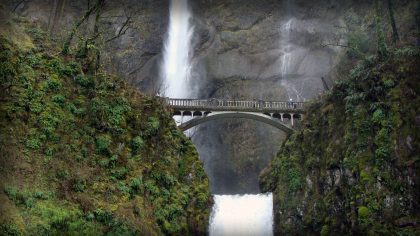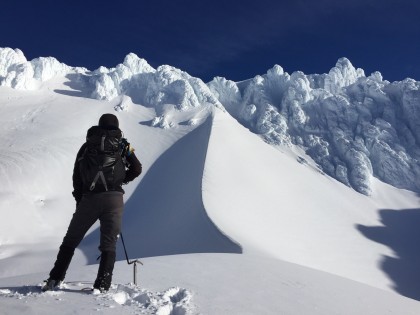At a glance
[/mk_fancy_title][mk_milestone stop=”11″ type=”text” text=”Round trip distance (miles)” border_bottom=”#eeeeee”][mk_milestone stop=”2485″ type=”text” text=”Elevation gain (feet)” border_bottom=”#eeeeee”][mk_milestone stop=”6″ type=”text” text=”Hiking time (hours)” border_bottom=”#eeeeee”][mk_milestone stop=”25000″ speed=”4000″ type=”text” text=”Steps” border_bottom=”#eeeeee”][mk_icon_box icon=”mk-icon-dollar” title=”Conditional Fee”]$5 per vehicle per day – On site payment not available.
OR[/mk_icon_box][mk_icon_box icon=”mk-icon-ticket” title=”NW Forest Pass”][/mk_icon_box][/vc_column_inner][vc_column_inner width=”1/3″][mk_fancy_title font_family=”none”]
When to go
[/mk_fancy_title][vc_progress_bar values=”%5B%7B%22label%22%3A%22Spring%22%2C%22value%22%3A%2275%22%2C%22customcolor%22%3A%22%2381f79f%22%7D%2C%7B%22label%22%3A%22Summer%22%2C%22value%22%3A%22100%22%2C%22customcolor%22%3A%22%23f4fa58%22%7D%2C%7B%22label%22%3A%22Fall%22%2C%22value%22%3A%2275%22%2C%22customcolor%22%3A%22%23faac58%22%7D%2C%7B%22label%22%3A%22Winter%22%2C%22value%22%3A%2225%22%2C%22customcolor%22%3A%22%23a9f5f2%22%7D%5D”][mk_fancy_title font_family=”none”]Relative difficulty
[/mk_fancy_title][vc_progress_bar values=”%5B%7B%22label%22%3A%22Beginner%22%2C%22value%22%3A%2275%22%2C%22customcolor%22%3A%22%23faac58%22%7D%2C%7B%22label%22%3A%22Intermediate%22%2C%22value%22%3A%2250%22%2C%22customcolor%22%3A%22%23f4fa58%22%7D%2C%7B%22label%22%3A%22Experienced%22%2C%22value%22%3A%2225%22%2C%22customcolor%22%3A%22%2381f79f%22%7D%5D” units=”%”][/vc_column_inner][vc_column_inner width=”1/3″][mk_fancy_title style=”avantgarde” size=”8″ font_family=”none” align=”center”]ADVERTISEMENTS
[/mk_fancy_title][vc_raw_html]JTNDc2NyaXB0JTIwYXN5bmMlMjBzcmMlM0QlMjIlMkYlMkZwYWdlYWQyLmdvb2dsZXN5bmRpY2F0aW9uLmNvbSUyRnBhZ2VhZCUyRmpzJTJGYWRzYnlnb29nbGUuanMlMjIlM0UlM0MlMkZzY3JpcHQlM0UlMEElM0MlMjEtLSUyMEhvbWUlMjBwYWdlJTIwcmVzcG9uc2l2ZSUyMGFkJTIwLS0lM0UlMEElM0NpbnMlMjBjbGFzcyUzRCUyMmFkc2J5Z29vZ2xlJTIyJTBBJTIwJTIwJTIwJTIwJTIwc3R5bGUlM0QlMjJkaXNwbGF5JTNBYmxvY2slMjIlMEElMjAlMjAlMjAlMjAlMjBkYXRhLWFkLWNsaWVudCUzRCUyMmNhLXB1Yi01NTM4NTAwNTg3MTA4NTQ2JTIyJTBBJTIwJTIwJTIwJTIwJTIwZGF0YS1hZC1zbG90JTNEJTIyMjU5Nzg2MTMxMSUyMiUwQSUyMCUyMCUyMCUyMCUyMGRhdGEtYWQtZm9ybWF0JTNEJTIyYXV0byUyMiUzRSUzQyUyRmlucyUzRSUwQSUzQ3NjcmlwdCUzRSUwQSUyOGFkc2J5Z29vZ2xlJTIwJTNEJTIwd2luZG93LmFkc2J5Z29vZ2xlJTIwJTdDJTdDJTIwJTVCJTVEJTI5LnB1c2glMjglN0IlN0QlMjklM0IlMEElM0MlMkZzY3JpcHQlM0U=[/vc_raw_html][/vc_column_inner][/vc_row_inner][vc_raw_html]JTNDaWZyYW1lJTIwaWQlM0QlMjJmb3JlY2FzdF9lbWJlZCUyMiUyMHNyYyUzRCUyMmh0dHAlM0ElMkYlMkZmb3JlY2FzdC5pbyUyRmVtYmVkJTJGJTIzbGF0JTNENDYuMDUwMCUyNmFtcCUzQmxvbiUzRC0xMjIuMzA0MSUyNmFtcCUzQm5hbWUlM0RDb3VnYXIlMkMlMjBXYXNoaW5ndG9uJTI2YW1wJTNCY29sb3IlM0QlMjMwMGFhZmYlMjIlMjB3aWR0aCUzRCUyMjEwMCUyNSUyMiUyMGhlaWdodCUzRCUyMjI0NSUyMiUyMGZyYW1lYm9yZGVyJTNEJTIyMCUyMiUzRSUyMCUzQyUyRmlmcmFtZSUzRQ==[/vc_raw_html][/vc_column][/mk_page_section][mk_page_section bg_image=”https://wanderlusthiker.com/wp-content/uploads/2016/07/ape_canyon_1080.jpg” bg_position=”right top” bg_stretch=”true” mask=”true” padding=”240″ full_width=”true”][vc_column width=”1/4″][mk_icon_text skin=”light” default_txt=”What is it?” link=”#What_is_it” icon=”mk-theme-icon-accordion”][/vc_column][vc_column width=”1/4″][mk_icon_text skin=”light” default_txt=”Where is it?” link=”#Where_is_it” icon=”mk-icon-map-marker”][/vc_column][vc_column width=”1/4″][mk_icon_text skin=”light” default_txt=”How did we do it?” link=”#How_did_we_do_it” icon=”mk-flaticon-compass39″][/vc_column][vc_column width=”1/4″][mk_icon_text skin=”light” default_txt=”Photos” link=”https://wanderlusthiker.com/portfolios/ape-canyon/” icon=”mk-li-photo”][/vc_column][/mk_page_section][mk_page_section][vc_column][mk_fancy_title tag_name=”h1″ font_family=”none”]What is it?
[/mk_fancy_title][vc_column_text responsive_align=”left”]Ape Canyon is what you might call a “light at the end of the tunnel” hike – not to be confused with the more popular Ape Caves or nearby Lava “the rope bridge” Canyon.[/vc_column_text][vc_single_image image=”28428″ img_size=”640×480″ add_caption=”yes” alignment=”center”][vc_column_text responsive_align=”left”]We talk about rewarding day hikes a lot on this site. And while the majority of them are mountains Ape Canyon is an exception. A common problem with mountain climbs is that you rarely get a chance to view the mountain in its entirety.Ape Canyon is the solution to that problem – providing wide, unobstructed, close-up views of the entire southeast side of Mt. St. Helens. But that’s not all…[/vc_column_text][vc_single_image image=”28430″ img_size=”full” add_caption=”yes” alignment=”center”][vc_column_text responsive_align=”left”]Parallel that with stories of a mysterious race of Ape-men who allegedly roamed the region. Occasionally they would poke their furry heads into the affairs of local inhabitants going back hundreds if not thousands of years. The most famous of these incidents was the 1924 attack on four men attempting to mine the area for gold.[/vc_column_text][vc_single_image image=”28432″ img_size=”640×480″ add_caption=”yes” alignment=”center”][vc_column_text responsive_align=”left”]As you may have gathered, most of the fun happens outside of the tree line, but whether you are mountain biking or exploring on foot, there is a lot to appreciate about this trail.
As the USDA makes abundantly clear, new and old growth forest is prolific on the trail, with occasional landscape teasers and seasonal flowers for your eyeballs. You know you’re getting close to the Loowit Trail junction when Mt. Rainier begins poking its glaciated peaks up over the distant hills. Mt. Adams and Mt. St. Helens make more frequent appearances and you won’t be able to get a decent glimpse of Mt. Hood until you reach the junction.[/vc_column_text][vc_single_image image=”28434″ img_size=”full” add_caption=”yes” alignment=”center”][vc_column_text responsive_align=”left”]During the spring and summer a thick, pungent, earthy, fir-tree perfume fills the air – accosting the nose and lungs; tempting the body with relaxation and calmness. The deep bellows of bullfrogs can be heard every so often and might be mistaken for the sound of Sasquatch. On certain sections of the trail a gentle, welcome breeze may find it’s way through the trees providing welcome respite from the heat of summer. Fortunately, the trees block most of the sun preventing you from being completely exposed.
Travel fast and light and you can be to Ape Canyon in 3 hours or less. A slower pace could extend the hike time to 4 hours. You should expect this to be a true all-day hike. There are no bathrooms at the trailhead or running water at any point on the trail. Camping is possible in a limited number of spots at the trailhead but there is more space near the junction with Loowit trail 5.5 miles in.[/vc_column_text][/vc_column][/mk_page_section][mk_page_section bg_image=”https://wanderlusthiker.com/wp-content/uploads/2016/07/ape_canyon_1080_5.jpg” bg_position=”center center” bg_repeat=”no-repeat” bg_stretch=”true” full_height=”true” full_width=”true”][vc_column][vc_column_text] [/vc_column_text][/vc_column][/mk_page_section][mk_page_section][vc_column][mk_fancy_title tag_name=”h1″ font_family=”none”]
Where is it?
[/mk_fancy_title][vc_column_text responsive_align=”left”]When planning a trip to Ape canyon the first thing we recommend is to check the road status on the USDA website.Forest road 83 is typically gated off during the winter months due to snow. Making the road impassable. It can continue to be gated off until late spring depending on conditions.
Parking at the trailhead can be crowded on weekends when there is clear weather.[/vc_column_text][vc_column_text][/vc_column_text][mk_fancy_title style=”avantgarde” size=”8″ font_family=”none” align=”center”]
ADVERTISEMENTS
[/mk_fancy_title][vc_raw_html]JTNDc2NyaXB0JTIwYXN5bmMlMjBzcmMlM0QlMjIlMkYlMkZwYWdlYWQyLmdvb2dsZXN5bmRpY2F0aW9uLmNvbSUyRnBhZ2VhZCUyRmpzJTJGYWRzYnlnb29nbGUuanMlMjIlM0UlM0MlMkZzY3JpcHQlM0UlMEElM0MlMjEtLSUyMEhvbWUlMjBwYWdlJTIwcmVzcG9uc2l2ZSUyMGFkJTIwLS0lM0UlMEElM0NpbnMlMjBjbGFzcyUzRCUyMmFkc2J5Z29vZ2xlJTIyJTBBJTIwJTIwJTIwJTIwJTIwc3R5bGUlM0QlMjJkaXNwbGF5JTNBYmxvY2slMjIlMEElMjAlMjAlMjAlMjAlMjBkYXRhLWFkLWNsaWVudCUzRCUyMmNhLXB1Yi01NTM4NTAwNTg3MTA4NTQ2JTIyJTBBJTIwJTIwJTIwJTIwJTIwZGF0YS1hZC1zbG90JTNEJTIyMjU5Nzg2MTMxMSUyMiUwQSUyMCUyMCUyMCUyMCUyMGRhdGEtYWQtZm9ybWF0JTNEJTIyYXV0byUyMiUzRSUzQyUyRmlucyUzRSUwQSUzQ3NjcmlwdCUzRSUwQSUyOGFkc2J5Z29vZ2xlJTIwJTNEJTIwd2luZG93LmFkc2J5Z29vZ2xlJTIwJTdDJTdDJTIwJTVCJTVEJTI5LnB1c2glMjglN0IlN0QlMjklM0IlMEElM0MlMkZzY3JpcHQlM0U=
[/vc_raw_html][/vc_column][/mk_page_section][mk_page_section bg_image=”https://wanderlusthiker.com/wp-content/uploads/2016/07/ape_canyon_1080_8.jpg” bg_position=”center center” bg_repeat=”no-repeat” bg_stretch=”true” full_height=”true” full_width=”true”][vc_column][vc_column_text] [/vc_column_text][/vc_column][/mk_page_section][mk_page_section][vc_column][mk_fancy_title tag_name=”h1″ font_family=”none”]How did we do it?
[/mk_fancy_title][vc_column_text responsive_align=”left”]We’ve hiked and biked Ape Canyon in the heat of summer, the icy grip of winter, and everything in between. It’s challenging and inspires adventure, but it is not a beginner’s hike and certainly not a place to test out your brand new mountain biking hobby. There is danger and opportunity to be found on this trail but it offers a truly rewarding experience.[/vc_column_text][mk_fancy_title tag_name=”h2″ font_family=”none”]Route
[/mk_fancy_title][vc_column_text responsive_align=”left”]So you got yourself up out of bed and you’re standing at the trailhead to Ape Canyon. The weather has been overcast the entire drive up and it’s kind of bumming you out, but that’s okay because nature![/vc_column_text][vc_single_image image=”28441″ img_size=”240×320″ add_caption=”yes” alignment=”center”][vc_column_text responsive_align=”left”]It’s okay – you can do that after you’ve finished the hike.[/vc_column_text][vc_single_image image=”28442″ img_size=”240×320″ add_caption=”yes” alignment=”center”][vc_column_text responsive_align=”left”]Good – Now that we’ve got that cleared up, you’ll need to prepare for 5 miles of forest hiking. It’s mostly uphill and unless you’ve got an affinity for trees then this section will be best recalled as the part you “endured.” The occasional glimpse of the lahar to your left leaves your imagination wanting more and you will get it – just not right now.[/vc_column_text][vc_single_image image=”28447″ img_size=”full” add_caption=”yes” alignment=”center”][vc_column_text responsive_align=”left”]There is no need to worry about getting lost on this hike as the trail is clearly defined and does not have any forks until you reach the Loowit trail junction at the end.The trail can be very narrow and overgrown in some areas. Because of this, the best practice is to be cautious both as a biker and a hiker. Be courteous to others at let them pass if they are moving faster than you are. Bikers will often tell you how many are in their group so that you can be on the lookout.[/vc_column_text][vc_single_image image=”28452″ img_size=”full” add_caption=”yes” alignment=”center”][vc_column_text responsive_align=”left”]The end of Ape Canyon trail plants you squarely at the base of Mt. St. Helens looking out over the vast, desolate Plains of Abraham. Turn around and you can look down from a sheer cliff that overlooks Ape Canyon. The view, on a clear day, extends north to the Goat Rock Wilderness and Mt. Rainier. To the east is Mt. Adams and the Indian Heaven Wilderness. Further south you can see Silver Star Mountain and Mt. Hood. All of this is incredible considering you’re not actually standing on a mountain yet you have a clear vantage point to many of the great nearby landmarks.[/vc_column_text][mk_fancy_title tag_name=”h2″ font_family=”none”]
Gear
[/mk_fancy_title][vc_column_text responsive_align=”left”]Most people don’t hike 11 miles in flip flops – We highly recommend comfortable boots or trail running shoes. A small pack with a medical kit and any other items you would bring on a standard day hike will suffice.Trekking poles can make a big difference in how you fare on this hike due to the elevation gains/losses. Don’t take our word for it though.
If you’re biking you should have a patch kit, portable tire pump, and the appropriate tools to repair your bike in the event something breaks.[/vc_column_text][mk_fancy_title style=”avantgarde” size=”8″ font_family=”none” align=”center”]
ADVERTISEMENTS
[/mk_fancy_title][vc_raw_html]JTNDc2NyaXB0JTIwYXN5bmMlMjBzcmMlM0QlMjIlMkYlMkZwYWdlYWQyLmdvb2dsZXN5bmRpY2F0aW9uLmNvbSUyRnBhZ2VhZCUyRmpzJTJGYWRzYnlnb29nbGUuanMlMjIlM0UlM0MlMkZzY3JpcHQlM0UlMEElM0MlMjEtLSUyMEhvbWUlMjBwYWdlJTIwcmVzcG9uc2l2ZSUyMGFkJTIwLS0lM0UlMEElM0NpbnMlMjBjbGFzcyUzRCUyMmFkc2J5Z29vZ2xlJTIyJTBBJTIwJTIwJTIwJTIwJTIwc3R5bGUlM0QlMjJkaXNwbGF5JTNBYmxvY2slMjIlMEElMjAlMjAlMjAlMjAlMjBkYXRhLWFkLWNsaWVudCUzRCUyMmNhLXB1Yi01NTM4NTAwNTg3MTA4NTQ2JTIyJTBBJTIwJTIwJTIwJTIwJTIwZGF0YS1hZC1zbG90JTNEJTIyMjU5Nzg2MTMxMSUyMiUwQSUyMCUyMCUyMCUyMCUyMGRhdGEtYWQtZm9ybWF0JTNEJTIyYXV0byUyMiUzRSUzQyUyRmlucyUzRSUwQSUzQ3NjcmlwdCUzRSUwQSUyOGFkc2J5Z29vZ2xlJTIwJTNEJTIwd2luZG93LmFkc2J5Z29vZ2xlJTIwJTdDJTdDJTIwJTVCJTVEJTI5LnB1c2glMjglN0IlN0QlMjklM0IlMEElM0MlMkZzY3JpcHQlM0U=
[/vc_raw_html][vc_single_image image=”28449″ img_size=”full” add_caption=”yes” alignment=”center”][mk_fancy_title tag_name=”h2″ font_family=”none”]Food & Water
[/mk_fancy_title][vc_column_text responsive_align=”left”]Lunch and a few snacks. It’s quite common to hike out in the morning, have lunch at a spot looking at the mountain around noon, then hike back in the afternoon. Snacking is encouraged as you will be burning a lot of calories.2 liters or more is recommended, as there are no dependable, fixed water sources. If you’re fortunate enough to encounter a snow melt stream in the Plains of Abraham, then you may be able to replenish your supply. Another alternative is to hike all the way up to the base of Mt. St. Helens to access the fresh glacial run off.[/vc_column_text][/vc_column][/mk_page_section][mk_page_section][vc_column][mk_fancy_title tag_name=”h1″ font_family=”none”]


